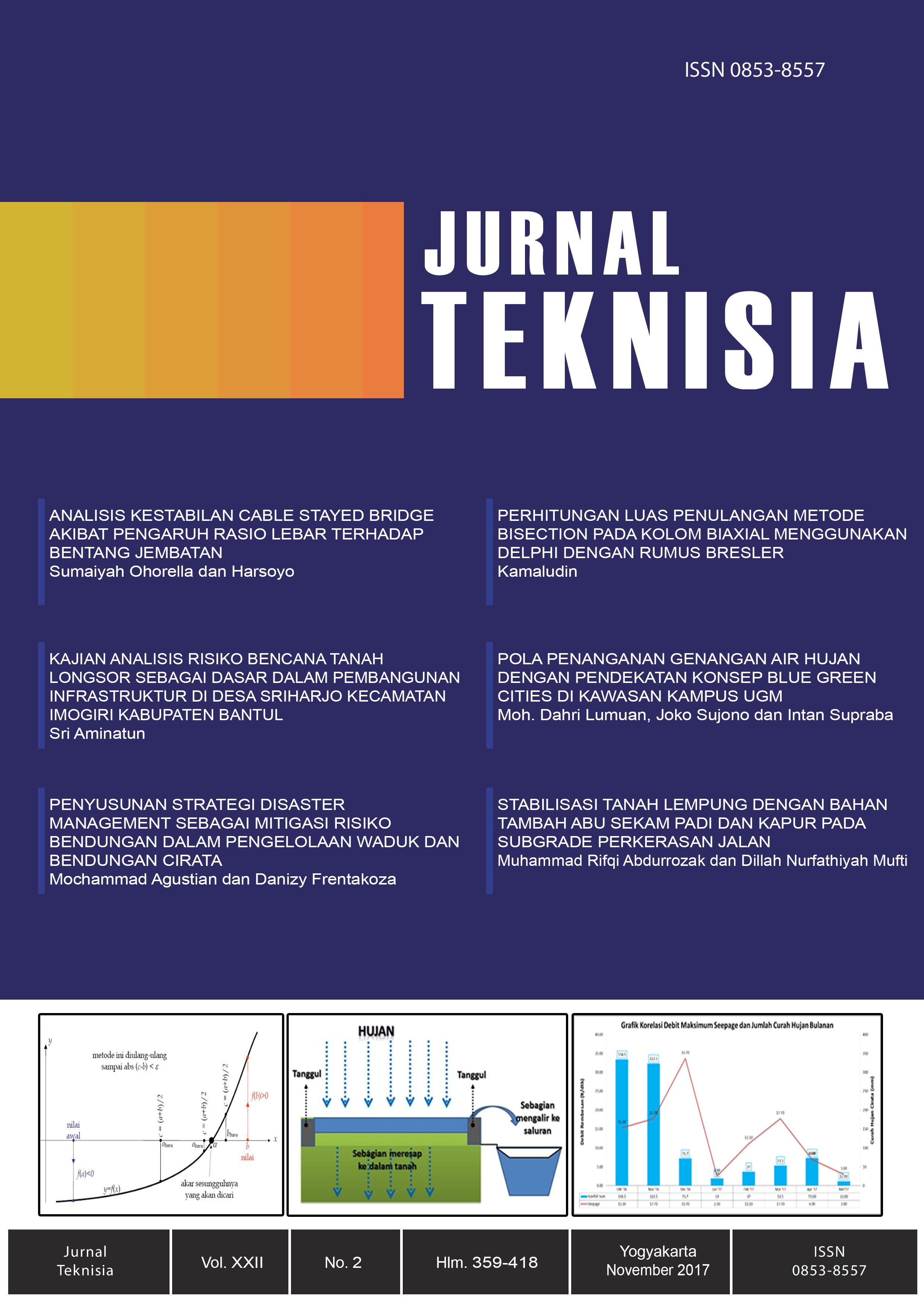Main Article Content
Abstract
Land use changes due to the expansion of the construction of educational infrastructure facilities at the Gadjah Mada University (UGM) Campus Area continue to develop. As a result, the open space is decreasing. This condition causes the ability of the land to absorbing rainwater decreases so that runoff of surface water increases, and cause inundation. This is evidenced by the presence of puddles at 15 points monitoring during rain events. The purpose of this study is to reduce rainwater nundation by absorbing water into the ground based on the Blue Green Cities (BGC)
concept. The method used is the green infrastructure method by building a absorbing
park/bearing park and roof garden. From the potential for the construction of absorbing park/bearing park covering an area of 517,740 m², only 9,006 m2 have bearing. While the potential of the roof garden is as large as 9,881 m², has not been used optimally. There is only one existing building has a garden roof, namely the Sanitary Engineering Laboratory in Kuningan. The calculation result of the capacity of the catchment garden in the rainy season period September 2016 to March 2017, the volume of rainwater that overflows was 8.14%. It is highly recommended that all existing parks be modified to be a garden with a beard, besides to maintain a green area can also reduce inundation points.
Keywords
Article Details
References
- Adriati, P. 2015. Pengurangan Limpasan Air Permukaan Dengan Pengembangan Green Infrastructure, V4N2 , hal 356-357. Bandung
- Blue Green Cities, http://www.bluegreencities.ac.uk/bluegreencities/about/blue- greencitiesdefinition. aspx (diakses 03 Oktober 2016).
- E. C. O’Donnell, J. E. Lamond & C. R. Thorne (2017): Recognising barriers to implementation of Blue-Green Infrastructure: a Newcastle case study, Urban Water Journal, DOI: 10.1080/1573062X.2017.1279190
- Friski, 2010. Pengaruh Teknik Konservasi Air Terhadap Debit Limpasan Lahan : Studi Kasus Kampus UGM daerah Graha Sabha Permana dan Sekitarnya, Universitas Gadjah Mada Yogyakarta.
- http://www.hollandwaterchallenge.com/indonesia/indonesia-2nd-edition/blue-green-cities.html (diakses 19 Desember 2016)
- Kibler, D.F. (1982). Urban Stormwater Hydrology, Vol. 7. Washington, DC: American Geophysical Union.
- Kementerian PUPR. 2016, Blue Green Cities, Indonesia – Netherlands Water Challenge 2016-2017, Jakarta.
- L. Hoang & R.A. Fenner (2016) System interactions of stormwater management using sustainable urban drainage systems and green infrastructure, Urban Water Journal, 13:7, 739-758, DOI: 10.1080/1573062X.2015.1036083
- Monumental CV. 2016. Perencanaan Teknis Drainase Lingkungan Kawasan UGM. Yogyakarta, 2016.
- Nursetiawan & Armi Imam Pratama (2017). Pengukuran Nilai Infiltrasi Lapangan dalam Upaya Penerapan Sistem Drainase Berkelanjutan di Kampus UMY, Jurnal Online Institut Teknologi Nasional, Jurusan Teknik Sipil Itenas | Vol. 3 | No.1
- Peraturan Menteri Pekerjaan Umum No. 5 tahun 2008, tentang penyediaan dan pemanfaatan ruang terbuka hijau di kawasan perkotaan.
- Peraturan menteri Pekerjaan Umum No. 12 tahun 2014, tentang penyelenggaraan sistem drainase perkotaan.
- Rencana Induk Pengembangan Kampus Universitas Gadjah Mada Tahun 2005-2015, Universitas Gadjah Mada Yogyakarta.
- Sujono, J. 2005, Survey Drainase Lingkungan Kampus UGM. Yogyakarta : Universitas Gadjah Mada.
- Thorne, C.R., et al. 2015. Overcoming uncertainty and barries to adoption of Blue Green infrastructure for urban flood risk management, Journal of Flood Risk Management, DOI : 10.1111/jfr3.12218. UK
- Undang undang nomor 26 tahun 2007, tentang penataan ruang.
- Wikipedia, hhtp://en.wikipedia.org/wiki/Blue-Green_Cities (diakses 03 Oktober 2016).
References
Adriati, P. 2015. Pengurangan Limpasan Air Permukaan Dengan Pengembangan Green Infrastructure, V4N2 , hal 356-357. Bandung
Blue Green Cities, http://www.bluegreencities.ac.uk/bluegreencities/about/blue- greencitiesdefinition. aspx (diakses 03 Oktober 2016).
E. C. O’Donnell, J. E. Lamond & C. R. Thorne (2017): Recognising barriers to implementation of Blue-Green Infrastructure: a Newcastle case study, Urban Water Journal, DOI: 10.1080/1573062X.2017.1279190
Friski, 2010. Pengaruh Teknik Konservasi Air Terhadap Debit Limpasan Lahan : Studi Kasus Kampus UGM daerah Graha Sabha Permana dan Sekitarnya, Universitas Gadjah Mada Yogyakarta.
http://www.hollandwaterchallenge.com/indonesia/indonesia-2nd-edition/blue-green-cities.html (diakses 19 Desember 2016)
Kibler, D.F. (1982). Urban Stormwater Hydrology, Vol. 7. Washington, DC: American Geophysical Union.
Kementerian PUPR. 2016, Blue Green Cities, Indonesia – Netherlands Water Challenge 2016-2017, Jakarta.
L. Hoang & R.A. Fenner (2016) System interactions of stormwater management using sustainable urban drainage systems and green infrastructure, Urban Water Journal, 13:7, 739-758, DOI: 10.1080/1573062X.2015.1036083
Monumental CV. 2016. Perencanaan Teknis Drainase Lingkungan Kawasan UGM. Yogyakarta, 2016.
Nursetiawan & Armi Imam Pratama (2017). Pengukuran Nilai Infiltrasi Lapangan dalam Upaya Penerapan Sistem Drainase Berkelanjutan di Kampus UMY, Jurnal Online Institut Teknologi Nasional, Jurusan Teknik Sipil Itenas | Vol. 3 | No.1
Peraturan Menteri Pekerjaan Umum No. 5 tahun 2008, tentang penyediaan dan pemanfaatan ruang terbuka hijau di kawasan perkotaan.
Peraturan menteri Pekerjaan Umum No. 12 tahun 2014, tentang penyelenggaraan sistem drainase perkotaan.
Rencana Induk Pengembangan Kampus Universitas Gadjah Mada Tahun 2005-2015, Universitas Gadjah Mada Yogyakarta.
Sujono, J. 2005, Survey Drainase Lingkungan Kampus UGM. Yogyakarta : Universitas Gadjah Mada.
Thorne, C.R., et al. 2015. Overcoming uncertainty and barries to adoption of Blue Green infrastructure for urban flood risk management, Journal of Flood Risk Management, DOI : 10.1111/jfr3.12218. UK
Undang undang nomor 26 tahun 2007, tentang penataan ruang.
Wikipedia, hhtp://en.wikipedia.org/wiki/Blue-Green_Cities (diakses 03 Oktober 2016).
